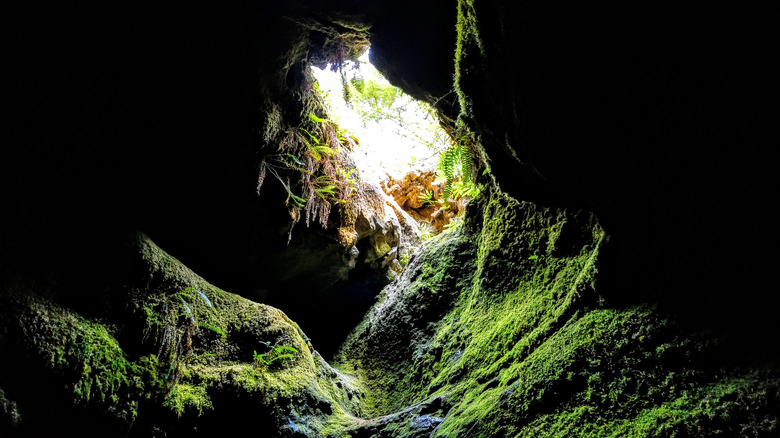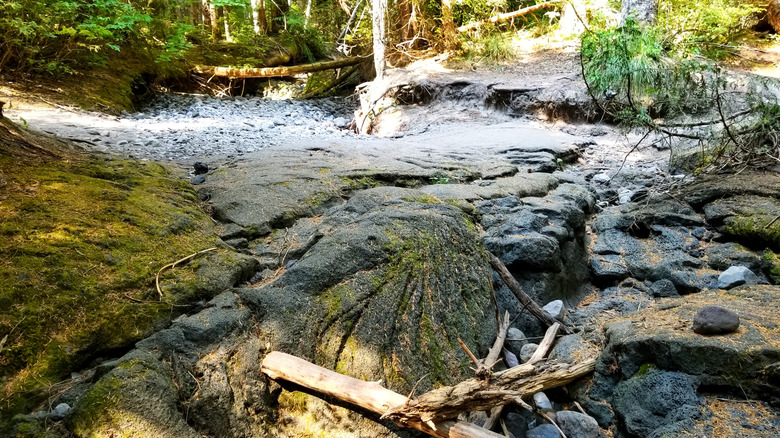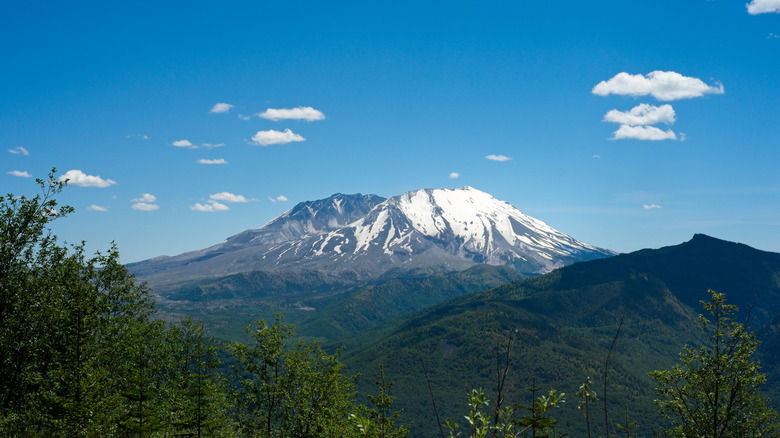America's Third-Longest Lava Tube Is A Unique, Family-Friendly Washington Experience With Wild Views
It's no surprise that Mount St. Helens is the source of some of Washington's most famed natural wonders, like the picturesque, heart-shaped Spirit Lake that survived the deadly 1980 eruption, but was transformed by it. The Ape Cave (or the Ape Caves) is the third-longest lava tube in the U.S., formed by Mount St. Helens about 2,000 years ago, when a basaltic lava flow ran down the volcano and hardened quickly to create a shell that molten lava could pass through. Luckily, the molten lava is long gone, and it left behind a volcanic cave-tunnel in the Gifford Pinchot National Forest, where visitors can walk through a fascinating geologic feature filled with lava-formed ridges, rock formations, and glossy lava. It's rare to find basalt in the area since Mount St. Helens typically produces a type of lava that doesn't cool quickly enough to form these tubes, so this is a unique way to connect with Washington's epic nature.
There are two trails to explore the Ape Cave: One is family-friendly and more easily accessible, while the other is better for those who want more of a gritty challenge. Don't worry about running into any apes in this underground site though. The name comes from the scout troop that first discovered the cave in the 1950s, who got their name from the nearby Ape Canyon –– so named because of alleged Bigfoot sightings in the 1920s. But you probably won't run into any of them either. With its location less than an hour and a half from Portland, Oregon, and about three hours from Seattle, the Ape Cave is ideal for a day or weekend trip to explore the awe-inspiring area around Mount St. Helens.
Two different trails, two different experiences
One of the most appealing features of the Ape Cave is its wildness. It's not maintained, so there aren't any walkways, railings, or other human interferences. This becomes especially clear on the longer of the two trails: Upper Cave Trail. It's 1.5 miles each way and the first part is all within the cave, while the return is via a forest path above ground. The Upper Cave Trail is the more difficult since it requires climbing over 27 or so rock piles and a slippery, 8-foot-high rock shelf that you scale with a rope, so it's not recommended for young kids or those with mobility issues. It's also not recommended for those who don't enjoy in small spaces, since the ceilings are lower and narrower than the Lower Cave Trail. One of the defining features of the Upper Cave Trail is the natural moss-covered skylights formed in the ceiling, which add an ethereal, otherworldly touch to this place that brings you in close contact with one of America's most active and unforgettable volcanoes.
The Lower Cave Trail is about three-quarters of a mile each way, and this 1.5-mile trek is completed entirely inside the lava tube. It's wider and with higher ceilings, so it's the more popular of the two (particularly with families). One of the highlights is the "Meatball," an appropriately named meatball-esque rock formation seemingly floating between the cave walls (sadly, it's not on a plate of volcanic spaghetti). Another unique feature is the "lavacicles," which are dripping stalactites formed by lava. It's less common for stalactites to be made from lava instead of water, so be sure to get your camera out for these intricately textured formations.
How to prepare for your Ape Cave visit
Due to its rugged nature, visiting the Ape Cave requires doing some preparation beforehand, like finding the best gear for taking a hike. The cave is open from mid-May to the end of October, 9 a.m. to 5 p.m. It stays cool at a constant 42 degrees Fahrenheit, so bring warm clothing to layer on, even in the summer. For the Upper Cave Trail, wear something that you won't mind getting dirty and bring a change of clothes. Sturdy shoes are a must, and you'll find a boot-brush outside the cave, which should be used before and after your visit. This is to prevent the spread of White Nose Syndrome, a fungus that's harmless to humans but deadly to bats, which can be tracked across caves via shoes and clothing. In addition, be sure not to wear anything that you've already worn in other caves.
You'll need something stronger than a cell phone light to see your way around. It's suggested that each person has two light sources. Headlamps (and extra batteries) are best for the Upper Cave Trail so you can have hands free for rock scrambling. Light sources can be rented at the Ape Cave office for about $10. Other than water, there's no food or drinks allowed, and both rock-collecting and wall-touching are prohibited to protect the ecosystem.
You have to book a timed reservation, which gives you a two-hour window to see the cave, and costs about $2 per person. A Northwest Forest Pass or America the Beautiful Pass is required to enter the park. You can purchase a Northwest Forest day pass for about $5, which offers access to all national parks in Washington and Oregon, or the annual America the Beautiful Pass for about $80, which enables you to visit all national parks around the U.S. Both of these passes can be purchased online from the Washington Trails Association.


